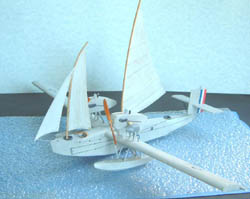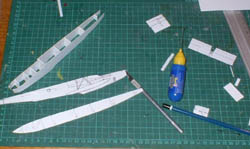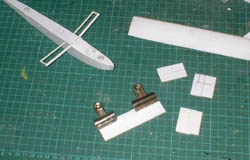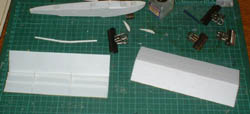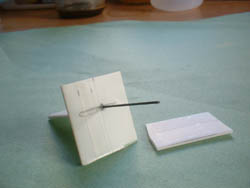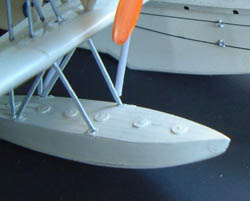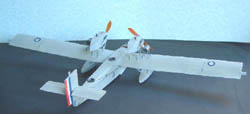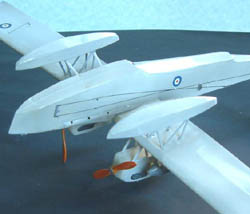Scratch-built 1/72 Beardmore InvernessBy Joel Christy |
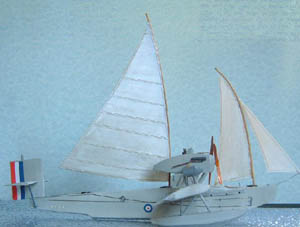 |
A Real Flying Boat
Is it a plane, is it a boat, a sailplane, a flying boat? What on earth is it? You might well ask. After building the largest aeroplane in 1928, the Beardmore Company decided to build a large flying boat in the same manner as the Inflexible aeroplane using Dr. Rorhbach’s stressed skin covering. Two aircraft were made, one in Berlin and the other in Dalmuir in Scotland. Besides being constructed entirely of metal they were unique in being equipped with a set of sails in case they were forced down at sea with unserviceable engines. This feature makes the Inverness a genuine “flying boat!” The aircraft flew well but whether the sails ever had to be used in an emergency is unknown. The idea isn’t so far fetched as many flying boats ended up taxiing to their destinations during World War Two for various reasons.
I found plans for the Inverness whilst researching the Beardmore Inflexible(see last months IM). I chose to model the aircraft in 1/72 scale as the Inverness was not as large as the Inflexible having a wingspan of only 92 feet as compared to the latters 157 feet. However construction of the aircraft was basically the same for both models.
I began by making the slab sides of the fuselage out of 15 thou styrene sheet as found on the lids of ice cream tubs. In fact 90% of the model was made of this material. How cheap can you get! Formers were made of 40 thou sheet and glued to the sides. I plunge formed a cockpit cowling over a wooden shape and glued it into place. Next the top decking was attached. The front of the main fuselage boat area was flat whilst the two steps had a slight keel and this was made of two halves. Once all was dry I cut out the three other cockpits and the two portholes.
Turning to the flying surfaces; these were made of 15 thou sheet folded over ribs to achieve an airfoil. Before constructing the wings I scribed the tops and bottoms according to the plans. Each wing section had four ribs attached to the lower side. Once dry the top half was folded over the ribs, glued at the trailing edge and clamped with office clamps. When all was dry the trailing edge was sanded down a bit to get a sharp edge. The thick rudder was made in the same manner as the wings whilst the elevator was simply sheet plastic folded over a 40 thou spine to get the proper airfoil. A piece of soft flower arrangement wire provided a way to mount the two elevator halves to the rudder. This assembly was then glued to the completed fuselage.
As with the Inflexible, the Inverness had a steep dihedral so I mounted the wings on pre-cut spars set into holes cut in the fuselage at the appropriate points. The two wing panels were then slipped over the spars and glued to the fuselage.
Once the main airframe was constructed I turned to the engines, radiators and wing floats. I plunge formed two engine fronts over a wooden plug. The rest of the engine nacelle was made of slabs of 15 thou sheet. The two Palmer radiators had plunge formed front cones with tiny slivers of 5 thou sheet to represent the vents. The main body was cut from a bit of ball point pen plastic and mounted on four wire legs. When finished the engines and radiators were attached to the wings with Contrail strut material and flower wire.
The two wing floats again were fabricated out of 15 thou sheet and built in a fashion similar to the fuselage. The tops were scribed and small punchings added to represent access covers. The bottom of each float was made up of two halves. I mounted the completed floats to the wings using flower wire flattened on a small anvil and then cut to length.
When all the bits had been attached to the airframe and were dry I painted the entire model with a coat of Humbrol number 40 gloss light grey. Once the paint was dry the decals were put on and details added. Engine exhausts were made from bits of sprue and flower wire. The cockpit combing was a bit of rolled Blue Tac covered with PVA glue. Before adding the control wires I gave the model two coats of a mixture of Tamiya white base and Future/Klear to dull the glossy finish. That finished the model except for those sails! I used kebab skewers for the masts and fabricated sails out of 15 thou sheet. I scribed them and covered them with a wash of lamp black and raw Siena oil paint to give them the appropriate nautical look. I attached the sails to the mast with super glue. Short lengths of plastic tubing glued to the front and middle cockpits served as mast steps. Lastly a bow sprit was added to the nose of the Inverness for the jib sail. And that completed my REAL flying boat. Now if I can just figure out a way of getting it all in the bottle!
